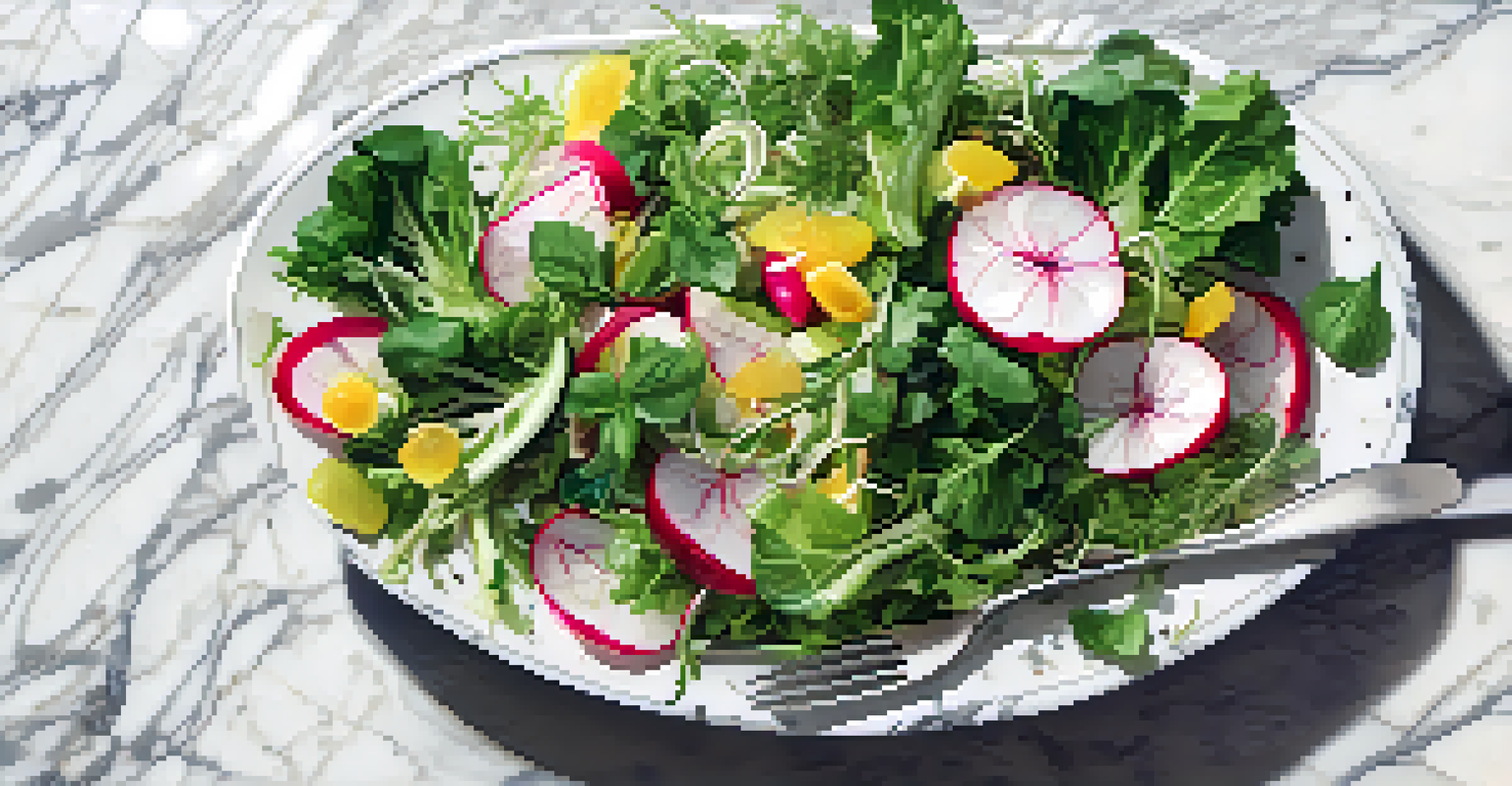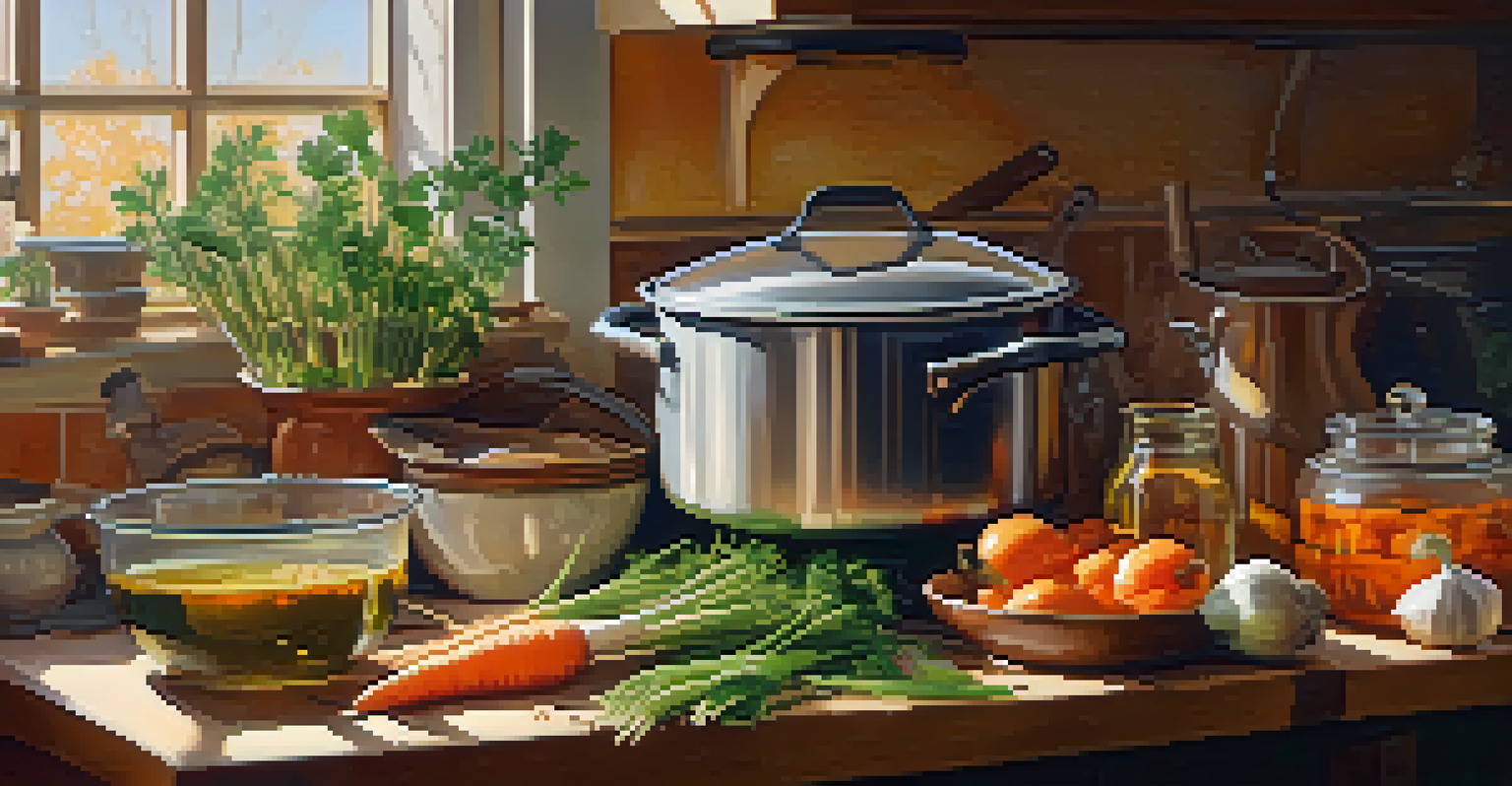How to Use Vegetable Scraps in Vegan Cooking for Less Waste

Understanding Vegetable Scraps and Their Benefits
Vegetable scraps are the leftover bits from your cooking, like peels, stems, and leaves. Instead of tossing them in the trash, consider their potential in your meals. Not only do they reduce waste, but they also pack a nutritional punch, adding flavors and textures that can elevate your dish.
Waste is a design flaw.
For example, carrot tops and beet greens are often overlooked but can be transformed into vibrant pestos or added to salads. By incorporating these scraps, you not only save money but also contribute to a more sustainable kitchen. It's a win-win for your wallet and the planet!
Embracing vegetable scraps encourages creativity in the kitchen. The next time you're chopping veggies, think of all the delicious possibilities that lie within the bits you usually discard.
Making Vegetable Broth from Scraps
One of the easiest ways to use vegetable scraps is by making homemade vegetable broth. Save your onion skins, garlic peels, and leftover stems from your veggies in a bag in the freezer. When you're ready, toss them into a pot, cover with water, and simmer for an hour or so.

This method not only extracts the flavors from the scraps but also gives you a rich, homemade broth that’s perfect for soups, stews, or even cooking grains. Plus, it's a fantastic way to customize your broth to your taste preferences by choosing specific scraps.
Transform Scraps into Broth
Homemade vegetable broth can be easily made from scraps, enhancing flavors and reducing waste.
Making vegetable broth is a simple yet effective way to utilize scraps and enhance your dishes. You might find this practice so rewarding that you'll never want to buy store-bought broth again!
Creating Flavorful Stocks and Sauces
In addition to broth, vegetable scraps can be cooked down into concentrated stocks or sauces. For instance, leftover tomato cores and skins can be simmered with herbs and spices to create a rich tomato sauce. Similarly, leftover onion and garlic scraps can add depth to your dishes when turned into a flavorful stock.
The greatest threat to our planet is the belief that someone else will save it.
These homemade stocks and sauces can serve as a base for countless recipes, allowing you to infuse your meals with robust flavors. Plus, knowing you’ve made them from scraps makes them even more satisfying.
By repurposing your vegetable scraps into stocks and sauces, you're not only minimizing waste but also enhancing the taste of your meals. It's a delicious way to practice sustainable cooking!
Incorporating Scraps into Smoothies
Did you know that vegetable scraps can also find their way into your morning smoothies? For example, using leafy greens like spinach stems or beet greens can add nutrients without altering the taste too much. Just blend them in with your favorite fruits for a nutritious kick.
Scraps like cucumber peels or celery leaves can add a refreshing twist to your smoothie, making it not only healthy but also vibrant. It’s an easy way to sneak in extra vitamins and minerals while reducing waste.
Creative Uses in Baking
Vegetable scraps like carrot peels and pumpkin puree can be incorporated into baked goods for added moisture and nutrition.
Next time you whip up a smoothie, consider tossing in some of those vegetable scraps. It’s a fun and inventive way to make your drink even healthier!
Baking with Vegetable Scraps
You might be surprised to learn that vegetable scraps can also be utilized in baking! Carrot peels, zucchini remnants, or even leftover pumpkin puree can be added to baked goods like muffins and breads. This not only adds moisture but also enhances the nutritional value of your treats.
Imagine biting into a delicious carrot muffin that’s not only sweet but also packed with nutrients from the peels you usually discard. It’s a fantastic way to surprise your taste buds while being gentle on the environment.
So, next time you’re baking, don't hesitate to experiment with vegetable scraps. Your baked goods will thank you, and so will the planet!
Crafting Vegetable Scrap Salads
Another creative way to use vegetable scraps is by crafting vibrant salads. Leafy greens can often be complemented with scraps like radish tops, broccoli stems, or even cucumber peels. These additions not only provide unique flavors but also add crunch and color to your dish.
Consider making a slaw with cabbage cores and carrot scraps, dressed with a zesty vinaigrette for a refreshing side. This approach not only reduces waste but also makes your salads more interesting and diverse.
Crafting Unique Salads
Incorporating vegetable scraps into salads not only minimizes waste but also adds flavor, texture, and visual appeal.
By incorporating vegetable scraps into your salads, you can create visually stunning and nutritious dishes that celebrate the beauty of whole foods. It’s a great way to enjoy the flavors of fresh produce while minimizing waste.
Preserving Scraps for Future Use
If you find yourself with a bounty of vegetable scraps, consider preserving them for future use. Techniques like pickling or fermenting can transform scraps into flavorful condiments that elevate your meals. For instance, pickled radish tops can add a tangy kick to sandwiches and salads.
Another option is to dehydrate scraps, like herb stems, to create homemade seasoning blends. This not only reduces waste but also allows you to have flavorful additions at your fingertips whenever you need them.

Preserving vegetable scraps is an innovative way to keep your kitchen sustainable while ensuring you always have delicious ingredients on hand. It’s all about being resourceful and creative!
Final Thoughts on Reducing Waste in Vegan Cooking
Using vegetable scraps in your vegan cooking is not just a trend; it's a lifestyle choice that can make a significant impact. By being mindful of what typically goes in the trash, you open up a world of culinary possibilities while contributing to a more sustainable food system.
From broths and sauces to salads and baking, the options are endless when it comes to utilizing scraps. This practice encourages us to think more critically about our food and embrace a zero-waste philosophy.
As you embark on your journey of reducing waste in your vegan cooking, remember that every scrap counts. With a little creativity, you can transform what once was considered waste into delicious, nourishing meals.